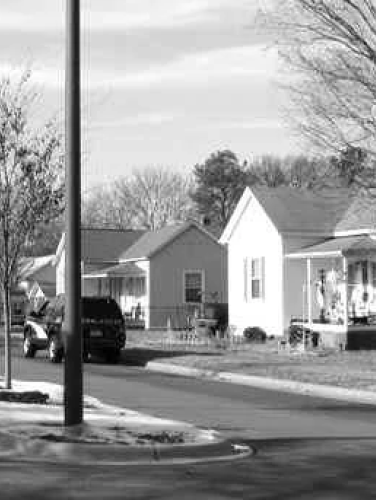
Park Avenue Neighborhood
(ca. 1890s)
Pineville’s Park Avenue neighborhood is the finest surviving collection of early twentieth-century mill houses in Mecklenburg County.
408 - 427 Park Ave., Pineville, NC 28134
The Park Avenue neighborhood of Pineville is a well-preserved block of eighteen mill houses situated along a wide street divided by a grassy tree-lined median. The owners of the Dover Yarn Mills, which opened in 1894 in the expansive brick manufacturing facility immediately to the west of Park Avenue, developed much of this accompanying mill village between 1894 and the early 1900s. Sixteen of the Park Avenue houses were part of that original phase of construction. In the 1920s, following its 1908 acquisition of Pineville’s cotton mill, Charlotte’s Chadwick-Hoskins Company commissioned noted local planner Earle Sumner Draper to renovate and expand the village. Draper’s mill village and neighborhood designs can be found across North Carolina, including in McAdenville, Forest City, Hendersonville, and Raleigh. The one-story T-plan dwellings along Pineville’s Park Avenue are the finest surviving collection of mill houses in Mecklenburg County, while the one-story, frame hip-roofed cottages are the only known existing examples of such structures within the county’s remaining mill villages. Park Avenue's wide divided street is the most significant element of Draper’s landscape plan for the village.
Property Quick Links
By 1902, just eight years after its 1894 opening, the Dover Yarn Mills already employed some 150 workers operating 9,000 spindles and 400 looms. Six years later, the mill became part of the Chadwick-Hoskins textile chain that controlled an expansive district of mills and mill villages along the Seaboard Air Line tracks northwest of downtown Charlotte. Even though the Pineville mill was the company’s only plant outside Charlotte, Chadwick-Hoskins soon became North Carolina’s largest textile corporation. By 1915, the Pineville mill (then known as Mill No. 5) was manufacturing white cotton sheeting with a workforce of 130, evenly divided between men and women. The mill and its village physically dominated Pineville, quickly becoming the town’s primary employer and builder. Twenty-five percent of Pineville’s 1910 population of approximately 600 residents worked in the mill, and many of those employees rented the mill village cottages from the mill’s owners.
In 1946, Greensboro’s Cone Mill Corporation acquired the Chadwick-Hoskins Company, including its Mill No. 5. In connection with its expansion and modernization of the Pineville mill, Cone upgraded the mill village with water and sewer lines and additional housing. By the late 1950s, Cone began selling open tracts of land around the periphery of the village for private residential development. Starting in the 1960s and continuing into the 1970s, Cone sold off its houses within the mill village, giving first priority to the mill worker families already living in those houses. Cone filed for bankruptcy in 2003, closing the Pineville plant as the company’s assets were sold off. However, Park Avenue and the greater mill village have remained remarkably well preserved and are an enduring historical asset for the town of Pineville.

